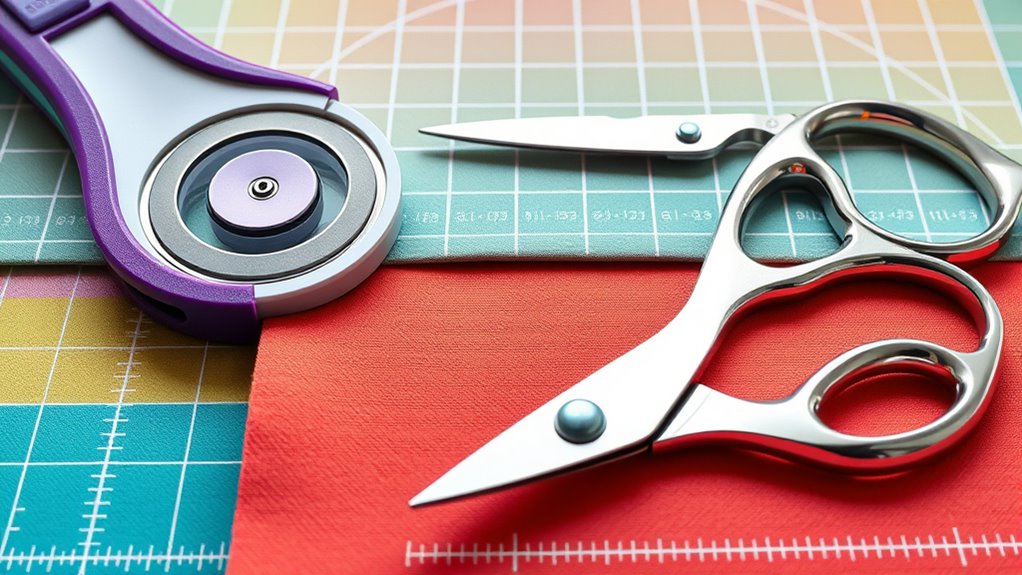To use a rotary cutter, scissors, and cutting mats safely and effectively, choose ergonomic tools for comfort and control. Keep blades sharp, replace dull ones immediately, and handle blades carefully to prevent slips or injuries. Always cut away from your body, use a stable surface, and store tools properly with safety caps. Regular maintenance guarantees safety and precision. Keep these tips in mind, and you’ll master the essentials for efficient cutting and safety—more detailed guidance awaits.
Key Takeaways
- Choose ergonomic rotary cutters and scissors for comfort and control during cutting tasks.
- Keep blades sharp, replace dull blades promptly, and handle tools with focus to ensure safety.
- Use durable, grid-lined cutting mats for precise measurements and stable cutting surfaces.
- Store blades with safety caps and cut away from your body to prevent injuries.
- Maintain tools regularly and follow proper techniques to improve accuracy and extend tool lifespan.
Choosing and Maintaining Your Rotary Cutter, Scissors, and Cutting Mats

Choosing the right rotary cutter, scissors, and cutting mats is essential for safe and precise fabric cutting. When selecting a rotary cutter, prioritize models with an ergonomic design, which reduces hand fatigue and increases control. This comfort makes blade replacement easier and safer, so look for cutters with accessible blades and simple mechanisms. For scissors, choose ergonomic handles that fit comfortably in your hand to enhance accuracy and reduce strain during extended use. Cutting mats should be durable with clear grid lines for precise measurements. Regular maintenance, like blade replacement when dull, keeps your tools performing at their best. Properly maintained, these tools help you cut accurately and safely, making your sewing projects more enjoyable and professional-looking. Additionally, understanding a growth mindset can encourage continuous skill improvement and problem-solving during your crafting process.
Proper Techniques for Using Rotary Cutters, Scissors, and Cutting Mats

Using your rotary cutter, scissors, and cutting mats correctly guarantees clean, accurate cuts and helps prevent accidents. Keep your blade sharp; a dull blade requires more force, increasing the risk of slips. Regularly check and replace blades as needed to maintain precision. When using scissors, grip them with an ergonomic grip to reduce hand fatigue and improve control. Position your hands comfortably and avoid overexertion. Apply steady, even pressure when cutting, following your marked lines or templates carefully. Use the cutting mat as a stable surface, aligning your materials properly before cutting. Keep your tools in good condition and handle them with focus, ensuring each cut is precise. Proper technique minimizes errors and enhances safety, making your cutting tasks more efficient.
Safety Tips and Best Practices for Cutting Tools and Surfaces

To guarantee safety when working with rotary cutters, scissors, and cutting mats, always prioritize proper handling and awareness of your surroundings. Keep blades sharp through regular blade sharpening; dull blades require more force and increase risk of slips. Store tools in designated storage solutions to prevent accidents and keep blades protected. When not in use, cover rotary cutter blades with safety caps and store scissors with blades closed. Always cut away from your body and keep fingers clear of cutting paths. Maintain your cutting surface clean and flat to ensure precise cuts and avoid slips. Be mindful of your environment, especially when handling sharp tools, and never rush. Additionally, proper technique is essential to prevent injuries and ensure efficient work. Following these practices helps minimize injuries and prolongs your tools’ lifespan, ensuring safe and efficient cutting every time.
Frequently Asked Questions
Can Rotary Cutters Cut Through Multiple Layers of Fabric at Once?
Yes, you can cut through multiple layers of fabric at once with a rotary cutter. Keep in mind that layer thickness affects your cut, so thicker stacks may require more passes. Also, make certain your blade is sharp; a dull blade can cause uneven cuts or tears. For best results, use a steady hand and apply even pressure, adjusting for the fabric’s thickness and the number of layers you’re working with.
What Materials Are Safe to Cut With Scissors and Rotary Cutters?
Cutting corners isn’t wise when it comes to material compatibility and safety considerations. Scissors and rotary cutters work best on fabrics, paper, and thin plastics. Avoid cutting harder materials like metal or thick leather, as they can damage your tools or cause injury. Always check the material’s suitability before cutting, and wear safety gear. Using the right tool for the job not only saves time but keeps you safe.
How Often Should I Replace My Cutting Mats for Optimal Performance?
You should replace your cutting mats every 4 to 6 months for maximum performance, depending on usage and maintenance. Regularly inspect your mats’ lifespan and perform cutting mat maintenance by cleaning and rotating them to prevent uneven wear. If you notice deep cuts, warping, or loss of grid lines, it’s time to replace the mat to guarantee precise cuts and safety during your projects.
Are There Specific Scissors Recommended for Delicate or Thick Fabrics?
A stitch in time saves nine, so choose the right scissors for your fabric. For delicate fabrics, use fine, sharp fabric scissors that cut smoothly without damage. For thick or heavy-duty fabrics, opt for heavy-duty shears with robust blades designed to handle tougher materials. Investing in quality fabric scissors guarantees clean cuts and preserves fabric integrity, making your sewing projects more precise and enjoyable.
Can Cutting Mats Be Used on Uneven or Textured Surfaces?
Cutting mats are not ideal for uneven or textured surfaces because they require surface stability for precise cuts. Using a mat on a rough or bumpy surface can compromise its protective features and cause slipping, risking injury or damage. Always place your cutting mat on a flat, smooth surface to guarantee proper mat protection and to maintain accuracy when cutting. This setup helps you work safely and efficiently.
Conclusion
By mastering these tools and techniques, you’ll cut with confidence and precision. Imagine you’re working on a quilt, carefully guiding your rotary cutter along the fabric, ensuring straight, clean lines. When you follow safety tips and maintain your tools, you’ll avoid accidents and extend their lifespan. With practice, you’ll turn your creative ideas into beautifully finished projects, making every cut count. So, keep practicing, stay safe, and enjoy the craft!










